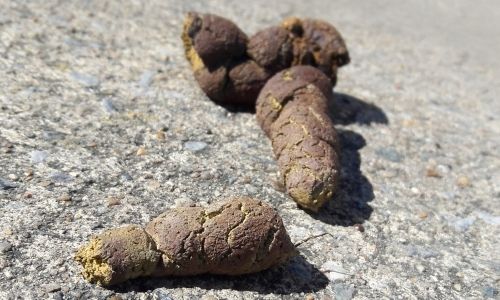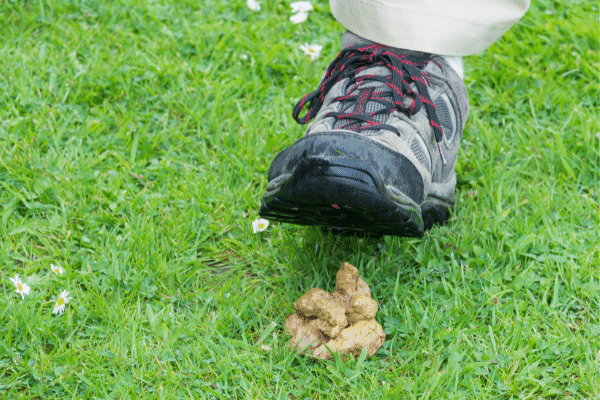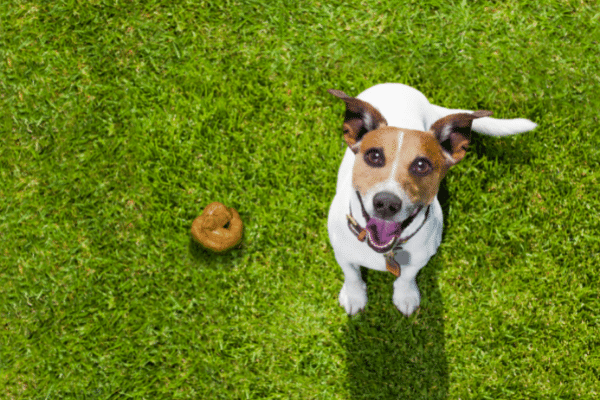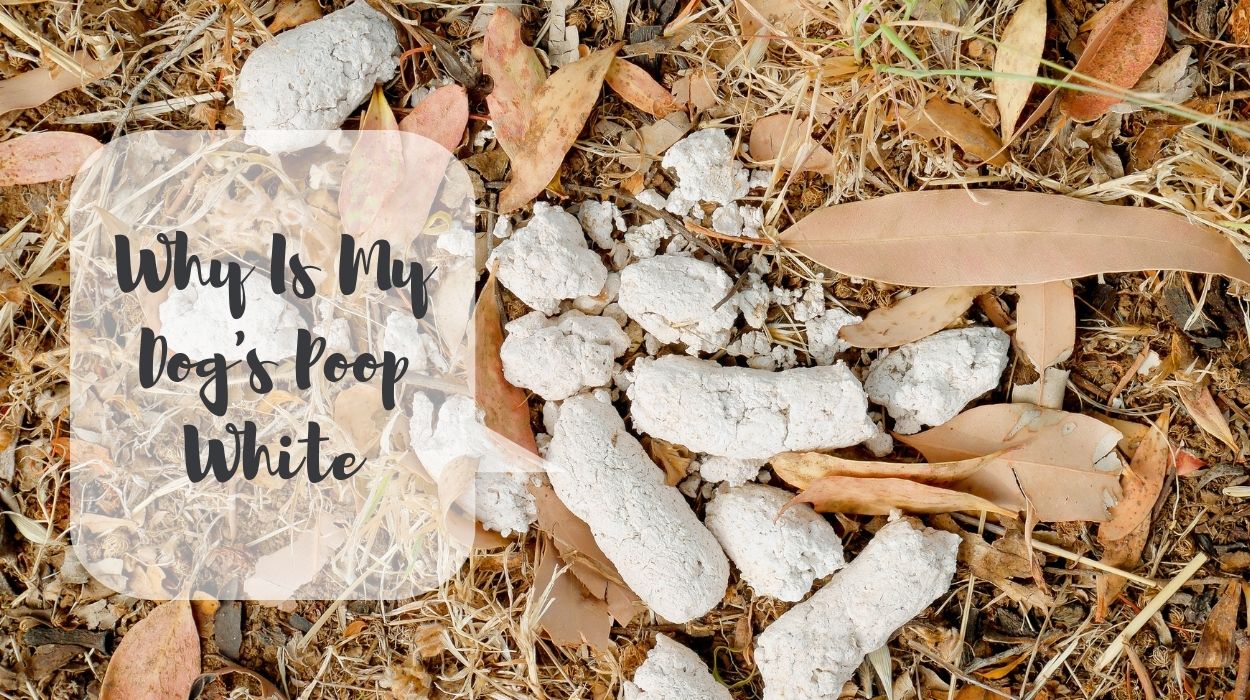You will be lucky enough as a pet parent if you can notice the change in the color of your dog’s poop, especially if it is white instead of the standard brown color because it firmly says that something is wrong with your dog’s digestive system.
This guide on the white dog poop is everything you need to get started. You will learn about why and what a white dog poop means! How to take care of it.
What Should Be the Color of Normal Poop?

Here, in this article, we will give all the answers to your question about the white color poop of your dog.
How will you know that there’s something wrong with the white color of your dog’s poop if you don’t even know the right color?
The short answer is color, constancy, coating, and smell; everything plays a vital role in determining your dog’s stomach health.
Color: The light brown color is the perfect color; depending on your pet’s food, it can range from golden brown to mahogany ingredients. It should not be runny and have a consistency of play-dough. Normal color poop for a healthy puppy: chocolate brown is the perfect poop color for your puppy.
Consistency: a healthy dog’s poop should be more firm in texture, just like a child’s soft modeling clay. As a general rule, it should be in log shapes with little cleaves so that if you were to roll it, it would crack into smaller bits.
Coating: you will not find any kind of coating on healthy poop. If you find anything on the top of your dog’s poop, which is noticeably sticky, then it should be a cause for concern.
Content: well, finding the content is purely the work of your dog’s vet, but if objects like a worm, fur, or other foreign material are found then, your dog needs medical attention.
As you noticed, all four things are essential to determine your dog’s health and play an indispensable role in the fragmentation of the color of the poop.
Note: the normal color poop for all the dogs is brown, but you need to understand that it can vary from breed to breed, and you can notice different shades of brown. The critical point is to catch the color of your dog poop more frequently so that you will know when it’s not normal.
Annotation of Colors
| brown | Indicates healthy bowel movement |
| green | Green poop indicates that your dog must have eaten grass. |
| Maroon or red | Sign of bleeding in the small intestine or stomach |
| White spots | Sign of worms present in your dog |
| Yellow | Sign that something is wrong with your dog’s liver, pancreas, or gallbladder. |
Why Does the Color of Your Dog Poop Matter?

The color of your dog’s poop plays a preeminent role in determining many things; though it does not sound like an enjoyable thing to do, trust me, it is the easiest way to look for your dog’s overall health.
The color of your dog’s poop will tell you if they are eating correctly or not, if they are unwell, or if the current food plan is suitable or not for them when it’s time to switch their food. Sometimes even white specks, which might look like rice grains, will realize that they are worms if you take a closer look.
The color of your dog’s poops does change based on the health of their stomach and intestines, depending on the health of their liver, pancreas, and even systemic diseases like infections.
For your better understanding, if your dog is facing difficulty digesting its food, which is an issue with its colon, its poop will turn red.
If you see the color of your dog’s poop is either white, black, or orange, please book an appointment with the vet.
7 Reasons Why Your Dog’s Poop Is White?

White color poop is never routine; it indicates that your dog must be having dietary issues triggered by more than one reason. Let’s dive deep into the possible side effects which made your dog’s poop white.
1. High-calcium diets
Yes, a high calcium diet can cause a dog’s white poop. Even too many good and healthy things can be troublesome. If you happen to be a dog parent who loves to treat their dogs with lots of bones, then stop and rethink your choice.
White color poop, due to a high calcium diet, occasionally is not a cause for concern, but too much calcium will make your dog constipated; it will strain them a lot during poop time.
Generally, your dog should receive one to two raw bones per week with a few days between each serving, but this may differ from dog to dog, so ask your vet for advice.
Apart from bones, some dairy products like yogurts, cheeses, and cottage cheese, are a great source of calcium for your dogs.
In vegetables, legumes such as broccoli, spinach, and beans are rich in calcium, but you got the least to worry about them as it’s improbable for our picky eaters to munch on veggies.
2. Medication Side Effects
Liquid barium is a medication that makes your dog’s poop white. So such medicines and treatments will change the color of your dog’s poop to white, but once it’s out of your dog’s system, it will turn back to normal.
3. Your Dog Ate a White Object
It’s a sunny day, you have been spending a good time on your couch, and all of a sudden, you remember how a few hours ago your silly pooch munched on toilet paper! You get up to go and check his poop; by seeing a white poop, you get all sorts of mini heart attacks in a fraction of seconds.
Dogs are very impatient creatures, and they want to put almost everything in their mouth!
Sometimes, these naughty creatures eat things they are not supposed to, like paper towels, toilet paper, tissues, feminine hygiene products, toys, fabric, and rocks.
Apart from making the color of your dog’s poop white, consuming these things can pose a danger if they get stuck in their system.
4. Environmental conditions
You might get to see white color poop more frequently in natural conditions of either humidity or heavy sunlight.
As soon as the poop breaks down, it grows mold and changes its color to white. But this environmental changing process takes a good three, four days! So if you find white poop in your backyard, the only suggestion we would give to you is to start cleaning your dog’s poop quickly without waiting for it to turn white or gray.
5. Tapeworms
Tapeworms are often compared with grains of short-grain rice in their appearance. If you look at what may seem like rice grains, you will see worms. If at all you happen to notice these worms in your dog’s poop, without wasting time, call your vet for a dewormer.
Though tapeworm eggs are visible to the naked eyes, an infestation of these worms can make your dog’s poop white.
How to prevent your dog from getting tapeworms:
- Keep your dog from coming in contact with intermediate hosts, which contain tapeworm larvae.
- Monthly heartworm prevention
- Flea control in dogs
- Don’t let your dog go to unsupervised places, especially in such areas where other dogs and animals are found.
- Keep your yards and parks clean.
6. Digestive Problems
Sometimes the mucus in your dog’s poop could make the whole poop look white! A little slime, we can understand, but when the real poop is covered in it, take it seriously! Because it suggests that your dog is having a tough time digesting its food.
7. Internal Illness
- Liver disorder: A lack of enzymes and bile production will lead to grayish-white stool. It is followed by a lack of appetite, jaundice-like symptoms, and weight loss in your dogs, which indicates that the liver is not functioning well.
- Exocrine pancreatic insufficiency (EPI): when your poor dog cannot produce pancreatic enzymes to digest fats, starches, and proteins in its diet, they have to deal with malabsorption and weight loss. Your dog’s stool will be of clay color, but this can be treated with medication and changing their regular diet.
- Bile Duct obstruction: The bitter, high alkaline fluid released by the liver plays a vital role in digestion and eliminating waste products from the body.
Bile is generated in the liver and then transported into the gallbladder, stored while the food takes time to digest.
It is then released into the small intestine to aid in food digestion and emulsify the food to be adequately utilized by the body or excreted as waste.
Tips to keep your dog’s poop healthy
Once you know that the white poop of your dog is abnormal, here are a few tips to keep your dog’s poop healthy!
- Do not even try to feed human food to your dog, no matter how much he drools for those fries in your hands; just don’t give it. The amount of oil and other such substances can cause dogs’ allergies and stomach issues.
- Always go for the highest quality brands while purchasing dog food.
- Some plants, vegetables, and fruits are toxic to dogs, so know what you grow in your backyard.
- Keep sanitizers, robust house cleaners, pest control, and other chemical substances out of your dog’s reach.
- Prevent your dog from exploring in trash and compost piles.
- Go for dog foods with no added preservatives, fillers, artificial flavor, etc.
FAQs About the Color of Your Dog’s Poop
Q. What does healthy dog poop look like?
Healthy dog poop is light brown, and it can range from golden brown to mahogany ingredients depending on your pet’s food. It should not be runny and have a consistency of play-dough.
Q. Can dogs poop become white after eating a bone?
The short answer is yes, dog poop can become white after eating a bone because bones have too much calcium. A diet full of calcium can be the primary reason for white color poop; it can also make your cat constipated.
Q. Is too much calcium bad for dogs?
Yes, too much calcium is inadequate for dogs. White color poop, due to a high calcium diet, occasionally is not a cause for concern, but too much calcium will make your dog constipated; it will strain them a lot during poop time.
Q. Can dog food affect poop color?
Many dogs have food allergies and sensitivities. These can cause digestive upset and even change the color of your dog’s stool, most commonly to an orange or yellow color.
Final word
Peeping into your dog’s poop to know what color it is might not be a job we all love to do! But it’s essential because it tells a lot about what is going on in that cutie’s system and means a lot about health.
A quick sneak-peek will give a crystal clear picture; look for the four things, color, consistency, coating, and content. If you find out that something is not on point, the next thing you need to do is take a fresh sample of your dog’s poop to the vet! One more gruesome work will save a lot of time for the vet.
We hope you got all your answers!
Did you find this information helpful? Let us know in the comment section below.

Dr. Aram Baker has been with Santa Clarita Animal Hospital since 1995 and his special interests include behaviour medicine and dermatology. He graduated from the Cleveland Humanities Magnet Program in Reseda, CA and attended California State University at Northridge where he received a Bachelor’s degree in biology. He went on to pursue his Doctorate in Veterinary Medicine at the University of California at Davis. He also spent time in the zoological medicine department at U.C. Davis during his Junior and Senior years. He is dedicated to caring for all pets big or small, young or old with compassion, patience, kindness, and love.
